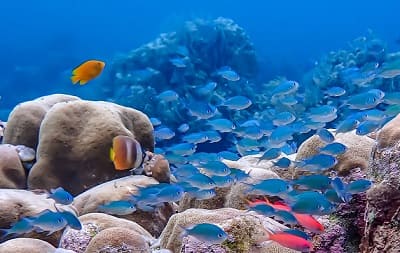Home › Locations › Asia › Indonesia › Bali › Candidasa › Blue Lagoon
Blue Lagoon Dive Site Candidasa Bali
The Blue Lagoon diving site and snorkelling location takes around 25 minutes to sail from Padang Bai harbour. The water is generally warm at this favourite spot and the fish life is colourful and abundant.
This guide contains interesting facts and information about the Blue Lagoon dive site, and why this spot is popular with underwater photographers.
Best Months for Diving 'Blue Lagoon' in Bali
Most of the Candidasa dive sites have good underwater visibility almost all year round (up to 20 metres).
However, the optimum months for scuba diving and snorkeling are May though to the end of October.
The dive spots at Padang Bai are better for beginners who are learning about diving, and for snorkelers.
Whereas, divers with more experience usually head out of the bay and dive on the locations closer to Candi Dasa.
But, moving away from the protection of the sheltered harbour means you may experience a mild current and surge. The Lombok Strait, which connects with the Indian Ocean, creates water movements that can be unpredictable and dangerous for novices.
Marine Life at Blue Lagoon Dive Site
To the casual eye, the underwater topography appears to be a small bay, with very little in the way of outstanding features. Even so, the white sand slopes its way to the ocean floor where you'll find a scattering of small coral reef structures.
One of the advantages of diving at this protected location is the calm conditions. In other words, scuba beginners and divers participating in underwater photography courses will find it to be an ideal setting.
After taking a short boat ride from Padang Bai harbour (about 10 minutes), reef sharks and bluespotted ribbontail rays are some of the resident marine life found at the Blue Lagoon dive site. Other 'lesser spotted' aquatic species include:
 Ghost pipefish
Ghost pipefish- Leaf scorpion fish
- Lionfish
- Moray eels
- Napoleon wrasse
- Nudibranchs
- Ocean sunfish (Mola Mola)
- Pygmy seahorses
- Reptiles (e.g. sea turtles)
- Spiny lobsters
- Whitetip reef shark
If you follow the southern section of the reef you will make a steep drop down to twenty (20) metres at the sand. This is a superb spot for photographers to shoot soft corals as they overhang the ledges.
The dive begins in the shallows at the northern section (around 5 metres deep). As you dive deeper, you will find fields of staghorn coral and feather duster worms as the slope drops down to the sand seabed around thirty (30) metres down.
Related Information and Help Guides
Pro Tip: The short video [1:45 seconds] shows the team from Blue Lagoon Snorkeling when they visited Tanjung Jepun Beach and the Blue Lagoon dive site.